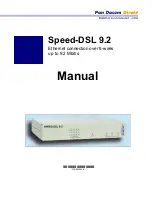
Quantum and Evolution Series Installation and Operating Handbook
8-25
%
o/h
Optimum
(n,k,t)
%
o/h
Optimum
(n,k,t)
%
o/h
Optimum
(n,k,t)
1.6 (254,250,2)
11
(202,182,10) 21 (115,95,10)
2 (204,200,2)
12
(187,167,10) 22
(111,91,10)
3 (206,200,3)
13
(174,154,10) 23
(107,87,10)
4 (208,200,4)
14
(163,143,10) 24
(103,83,10)
5 (210,200,5)
15
(153,133,10) 25
(100,80,10)
6 (247,233,7)
16
(145,125,10) 26 (97,77,10)
7 (245,229,8)
17
(138,118,10) 27 (94,74,10)
8 (243,225,9)
18
(131,111,10) 28 (91,71,10)
9 (242,222,10)
19
(125,105,10) 29 (89,69,10)
10 (220,200,10)
20 (120,100,10)
30 (87,67,10)
For other values of overhead (o/h expressed as 1.xx), maximise `t` then:
n
= Round( (2 x o/h x t) / (o/h - 1) )
k
= n - 2t
If `n` is greater than 255, reduce `t`.
For some applications, particularly when operating with lower data rates, a reduction in the
processing delay associated with Reed-Solomon FEC is the prime goal. In such
circumstances use the `Custom Features` feature and select shorter codewords to reduce
the encoder / decoder & interleaver / de-interleaver delay. For example switching from
Intelsat standard values of n, k, t = 126, 112, 7 to 64, 56, 4 provides approximately the
same correction ability (7 in 126 = 5.5% and 4 in 64 = 6.25% respectively) with similar
overheads (126/112=12.5%, 64/56=14.3%) but with interleaving & decoder delays reduced
from 5632 to 3104 bits (156ms to 85ms at 32kbps).
8.9 Data and Symbol Rates
The normal constraint for a modem is the range of
Symbol Rates
over which the modem
can operate correctly. The Symbol Rate range however is not of initial interest to most
modem users, as they first need to know if the modem can operate at the terrestrial
Data
Rate
they require. This section briefly explains the relationship between Data Rates and
Symbol Rates.
















































